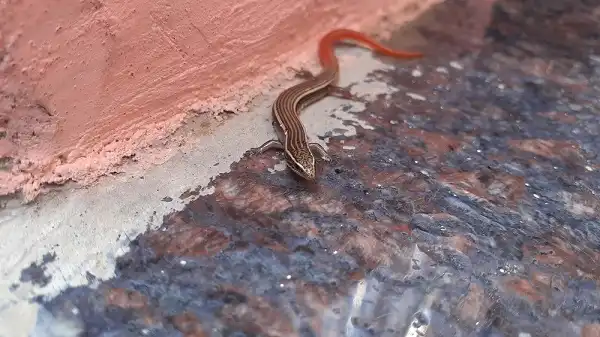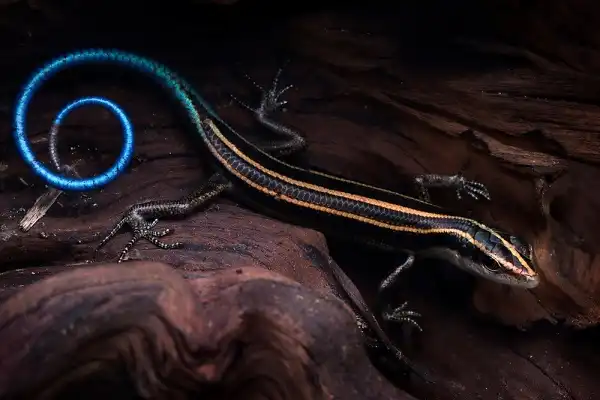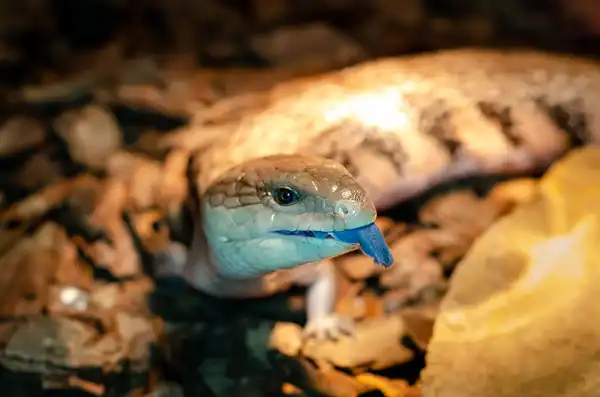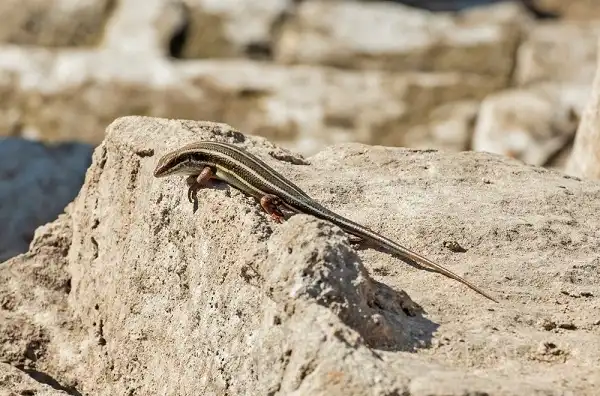Are you looking for a unique and fascinating pet? Then the skink lizard might be exactly what you’re after! Not only can this reptile make an interesting conversation piece, but it’s also fun to care for. Skink lizards are surprisingly hardy little creatures whose active personalities will win your heart in no time. In this blog post, we’ll go over the different types of skinks available to pets, some of their key care requirements, and how to ensure they stay happy and healthy. So if you’re looking for an adorable new pet that’s easy to maintain then read on – because the skink lizard is one companion that won’t let you down!

Skink Lizard Description
Skink lizards are small reptiles that come in a variety of sizes, colors, and patterns. The most common types of skinks kept as pets are the blue-tongued skink, the five-lined skink, and the fire skink. Skinks have a long, slim body with short legs and feet. They have distinctive scaly skin that can be light brown or gray, with dots, stripes, or blotches in shades of yellow, orange, or red. Blue-tongued skinks have a bright blue tongue which is where they get their name from. Skinks are active lizards who love to burrow and climb. They have claws on their toes to help them grip surfaces when climbing trees or rocks. Skinks also possess excellent eyesight – they can see up to thirty feet away! They also have great hearing and a sense of smell – both of which will come in handy if they ever need to escape predators in the wild.
Skink Lizard Habitat
Skink lizards require a well-ventilated, secure enclosure in order to thrive. A good rule of thumb is to have an enclosure that is at least twice the length of your skink’s body. To ensure their safety, it’s important to provide locking mechanisms on the doors or lids of the tank so that your pet can’t escape. The enclosure should be filled with substrates, such as coconut fiber or reptile carpet, which will help maintain humidity levels and give your pet something to burrow and dig in. You’ll also need to provide several hiding spots around the enclosure for your skink to feel secure. These can include small cork bark logs, rocks, or hollowed-out logs – all of which will allow them to feel comfortable and hide away when needed.
In addition to providing ample space inside their enclosure, you’ll also need to create a warm and humid environment for your skink. This can be done by using a heat lamp or ceramic heater placed at one end of the tank. The temperature should be kept between 75-85°F during the day and dropped down to 65-70°F at night. Providing a basking spot around 100°F is also necessary for helping your skink stay healthy and active during the day. In order for these temperatures to be maintained, it’s important that you have a reliable thermometer inside the tank that you check regularly. You’ll also need regular misting sessions inside the enclosure in order to keep humidity levels high – this can help prevent respiratory problems from occurring in your pet skink due to dry air conditions.
Skink Lizard Diet
Skink lizards have omnivorous diets, meaning they eat both plants and small insects. In the wild, their diet consists of a variety of fruits, vegetables, flowers, and insects such as crickets, mealworms, waxworms, and earthworms. When it comes to domestic skinks, it’s important to provide them with a balanced diet including fresh produce and store-bought food items. When selecting produce for your pet skink make sure that all fruits and vegetables are washed before feeding. For example, spinach leaves can be a great source of vitamins A and C while carrots offer vitamin A and dietary fiber.
Other suitable greens include collard greens, mustard greens, turnip greens, and kale – all of which provide essential nutrients for your skink lizard. Fruits such as papaya or banana can also serve as an occasional treat. It’s also important to provide calcium supplements for your skink lizard regularly in order to help keep its bones healthy and strong. The amount provided should depend on the size of your skink so consult with a qualified veterinarian beforehand if needed. Lastly, you’ll want to dust any live prey items offered with Vitamin D3 powder prior to feeding in order to ensure that your pet receives sufficient amounts of this vital nutrient.

Skink Lizard Size
Skink lizards vary in size, depending on the species. The smallest species is the Dwarf Skink, which can reach lengths of just 4 inches (10 cm). On the other end of the scale, some Five-lined Skinks and Shingleback Skinks can reach up to 12 inches (30 cm) in length. The average skink lizard weighs between 1.5 ounces and 5 ounces (43 to 142 grams), depending on the species and age of the animal. Females are typically smaller than males due to their reproductive organs taking up a significant amount of space within their body cavity.
Skink Lizard Lifespan
Skink lizards have a wide range of lifespans depending on the species. Some skink lizards, such as the blue-tongued skink, are known to live for up to 20 years or more with proper care. On average, most species of skink lizards will live between 3 and 15 years in captivity. However, factors such as diet, environment, and health can have an effect on a skink lizard’s lifespan.
In addition to nutrition, providing an appropriate environment is another essential factor that will determine how long your skink lizard will live. Skinks require an enclosure that is at least twice the length of their body with plenty of ventilation and secure locking mechanisms on the doors or lids of the tank so they can’t escape. Regular misting sessions are also needed in order to maintain humidity levels within the enclosure in order for these temperatures to be maintained properly.
Skink Lizard Behavior
Skink lizards are active creatures that prefer to remain hidden from predators during the day and can often be seen out and about at night. They usually spend their time exploring or basking in their enclosure, sunning themselves to keep warm. Skinks are solitary animals, meaning they don’t interact much with other skinks. If two skinks do happen to meet, it is usually only for brief periods of time before they go their separate ways again. Skinks also use scent signaling as a way to communicate with one another. They have glands located below their eyes known as preocular glands which secrete pheromones that can be used to identify each other or mark paths in the wild. In captivity, these pheromones can be used by owners as a way of calming the animal down or encouraging certain behaviors.

Skink Lizard Speed
Skink lizards are relatively fast animals, able to move quickly and effortlessly on their short legs. The typical skink lizard can reach top speeds of up to 1 meter per second (3.6 feet per second), with some larger species reaching up to 2 meters per second (7.2 feet per second) when alarmed or threatened. They also have the ability to make short “sprints” when needed, enabling them to quickly changes directions or avoid obstacles in their environment. The speed of a skink lizard can also be influenced by its diet and health. For instance, if the skink is not getting proper nutrition it may not be as agile or quick as one that is receiving a balanced diet with adequate amounts of protein and vitamins. Additionally, a skink that is underweight or has health issues such as parasites can also experience reduced speeds due to those conditions affecting its overall agility and strength. Interestingly, some skinks use a tail-flicking behavior when they feel threatened which appears to help them increase their speed by creating an illusion that they are bigger than they actually are. This behavior serves as a warning sign for potential predators and helps them escape from danger faster than if they had remained still.
Skink Lizard Reproduction
Skink lizards reproduce sexually, with males and females typically mating in the spring or summer months. The female will usually lay a clutch of eggs which can range from 2-20 depending on the species. The eggs will then hatch between 4-12 weeks later, depending on environmental conditions such as temperature and humidity. During the mating process, males are known to engage in courtship behavior such as head bobbing or nose touching in order to attract a mate. Depending on the species of skink lizard, they may also use their brightly colored throat scales as a visual display of their sexual maturity and fitness level. Most skink lizards are oviparous (egg-laying) animals, meaning that they lay eggs outside of the body and do not provide parental care for their offspring. However, there are some species that exhibit viviparity (live birth) and a few even provide maternal care after giving birth.
Skink Lizard Hunting
Skink lizards are naturally cautious and agile animals, making them difficult to catch in the wild. They use a combination of scent signals, vibrations, and visual cues to detect potential predators and flee from danger. Skinks rely on their speed and agility to outrun predators, as well as their ability to hide in small crevices or underground burrows when necessary. When hunting skinks, it is important to be aware of their behavior patterns so that you can anticipate where they will go next. Skinks tend to move in short bursts of energy across the ground, often stopping quickly before making a different direction change.
This makes it difficult for potential predators to follow them, so it’s important for hunters to be extra observant in order to spot any changes in movement or direction. It is also important for hunters to remember that skinks are omnivores and hunt both plant and animal matter. In order to successfully capture a skink, bait can be used such as nuts, fruits, or insects depending on the species being hunted. The bait should always be placed close enough for the skink to reach but far enough away that they won’t get scared off by your presence.

Conclusion
Overall, skink lizards are fascinating creatures with a variety of unique characteristics that make them enjoyable to care for and observe. From their impressive speed and agility to their reproductive habits and hunting methods, skinks can provide an interesting and exciting addition to any home or garden if given the proper care they deserve. With the right diet, environment, and handling they can live long happy lives in captivity!
Frequently Asked Question


